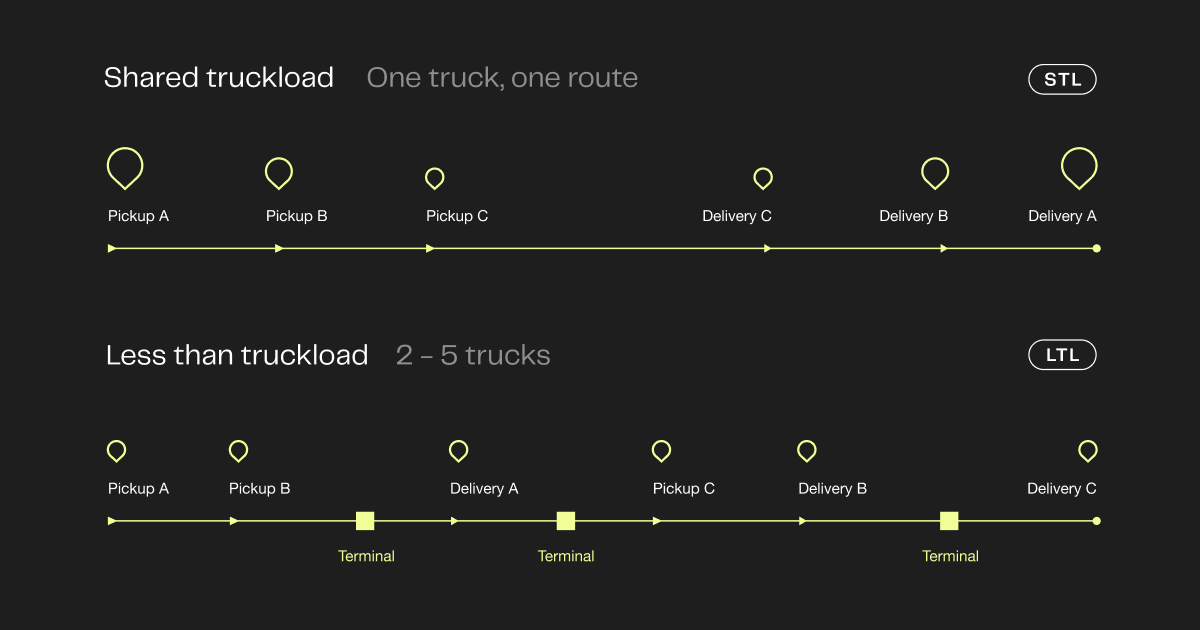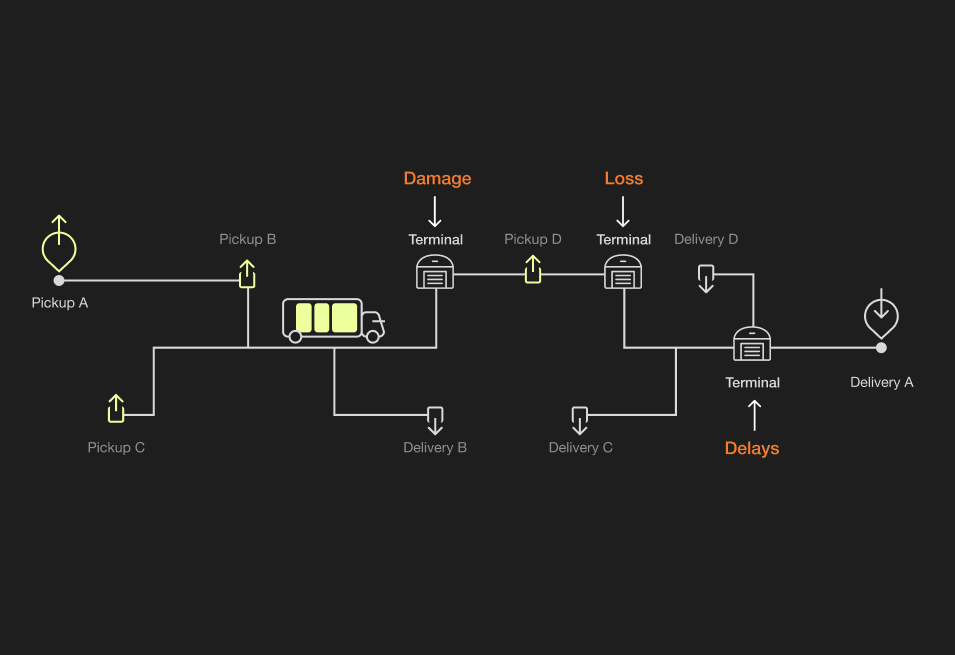Shipping LTL vs STL

Ready to try ÃÛÌÒ´«Ã½?
Carrier sign upWhen you’ve got goods to move, one way to move them is to hire a trucking company, fill a trailer with cargo, and send it directly to its destination. Truckload shipping, also known as Full Truckload or FTL, is a fast, reliable shipping method, perfect for large companies that ship large amounts of freight.But what if you ship goods in smaller amounts? Traditionally, shippers have had to choose between paying for a truckload without actually having enough freight to fill the truck or settling for a less-than-dependable less-than-truckload option.

What is less-than-truckload shipping?
Less-than-truckload, also known as LTL shipping, allows you to move smaller loads without waiting until you can fill a trailer to capacity. By shipping LTL, you can combine your smaller loads with other shipments and share the expense with other shippers. LTL shipping is ideal for freight that is:
- smaller than 9 pallets
- takes up less than 12 linear feet of trailer space
- weighs 150-15,000 pounds
LTL shipping generally costs less than FTL since you only pay for the space you use, but it frequently comes with additional risks and fees. For example, when you ship LTL freight, your cargo is handled more often at distribution centers and terminals along the route, so it could be damaged or lost while unloading and reloading. Unexpected delays affecting delivery times may also occur. At the same time, LTL freight rates may include extra fees related to freight re-classification and accessorials.
What is shared truckload shipping?
What if there was a better way to ship your less-than-truckload freight? Shared truckload, or STL shipping, is a smarter, faster, more sustainable option for shipments that don’t fill a trailer to capacity. Like LTL, STL shipping allows businesses to combine freight with other shipments to optimize trailer capacity. By sharing trailer space, each shipper only pays for the portion of the trailer they use — helping you cut shipping costs by up to 20%. When you book an STL delivery, patented online freight technology uses machine learning to match shipments to available trucks in the same shipping lane, keeping routes terminal-free. Not only does this reduce the risk of damage or loss during transit, but it can also lead to faster transit times. Shared truckload shipping can also help you reduce your company’s carbon footprint. Consolidated shipments mean fewer trucks traveling with under-utilized space, reduced fuel consumption, and up to 40% lower carbon emissions compared to traditional FTL shipping.
Similarities of shipping LTL vs. STL.
Both LTL and STL shipping involve combining multiple shipments on a single truck. These methods share several similarities.
- Cost Savings: Both strategies are cost-effective compared to booking a full truckload for smaller shipments.
- Consolidation: Both methods combine shipments from multiple customers into a single multi-stop truckload, so shippers can pay only for the space they use.
Key differences between shipping LTL vs. STL.
Because of their similarities, you may see the terms LTL and STL used synonymously in the media, but there are some key differences:
- Shipment Size: While LTL shipments face strict size limiations (typically up to 9 pallets), STL can accommodate larger cargo (up to 20 pallets) while still allowing shippers to only pay for the space they need.
- Freight Class: LTL cargo is assigned a specific freight class, which may affect pricing and weight allowances. STL, however, can accommodate a variety of freight types and leverages the truckload network, eliminating the need for confusing freight classes.
- Weight Restrictions: STL weight restrictions are far less stringent than LTL, providing more flexibility to accommodate heavier shipments.
- Accessorial Fees: When you ship LTL freight, you may incur additional charges such as re-weigh, re-class, or residential fees, and you may pay for accessorials like liftgates, notification calls, or inside delivery. With STL, you get the best rates without any unexpected expenses.
- Reliability: Shipping LTL can get your shipment out the door faster than FTL, but terminal stops can result in delays, damage, and loss. In fact, 89% of LTL shippers dealt with damaged freight in 2022 — and shippers paid an average of $1,988 for damaged and late LTL shipments. STL freight travels on a terminal-free route directly to its destination, so it isn’t handled during transit. The result is your shipment arrives intact and on time.
- Monitoring: Tracking LTL shipments can be complicated with distribution center stops and multiple trucks. STL shipments, on the other hand, stay on a single truck for the entire trip, making it easier to monitor its location at any given time.
- Environmental Benefits: By consolidating shipments and skipping energy-intensive terminals, STL can help reduce the number of trucks on the road, making STL an environmentally friendly option for smaller loads.
Choosing the best mode for your load.
Many factors go into choosing the right freight service for your business. When comparing LTL shipping options before you ship, you’ll need to consider factors like:
- size, weight, and dimensions of your freight
- special handling requirements
- time-sensitivity and scheduling constraints
- supplier and customer preferences
- shipment monitoring and communication
- budget requirements
Regardless of your shipment size, ÃÛÌÒ´«Ã½ is a partner you can count on for affordable rates, increased efficiency, and on-time, damage-free delivery. Our team can help you determine the best mode for your shipping needs.ÃÛÌÒ´«Ã½Direct® offers efficient, cost-effective shipping options — including our unique STL offering — to help you meet your business goals. Our patented freight technology matches compatible shipments with empty trailer space along your desired route, making shipping simpler and more affordable. Learn more about shared truckload shipping and request a demo today.



